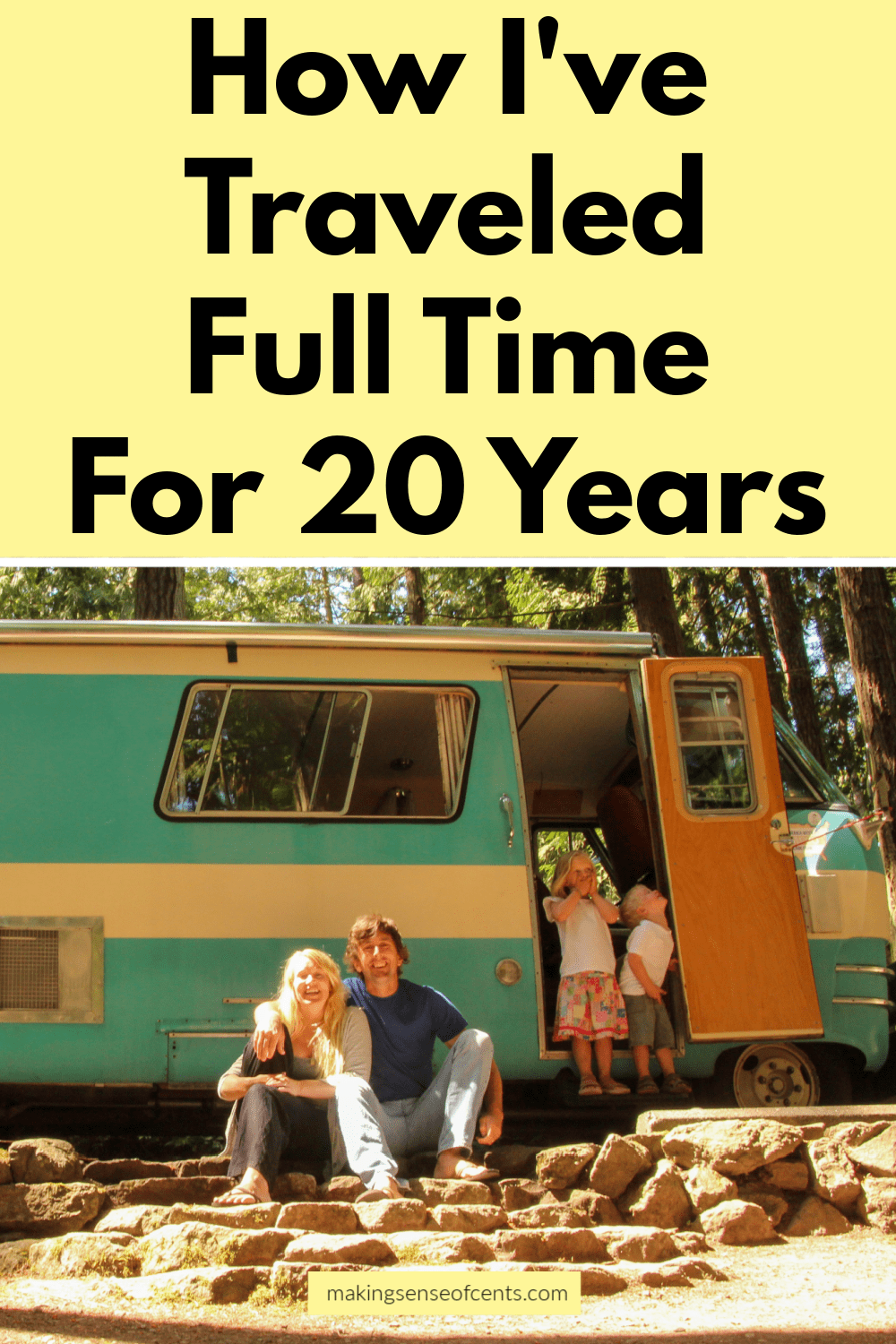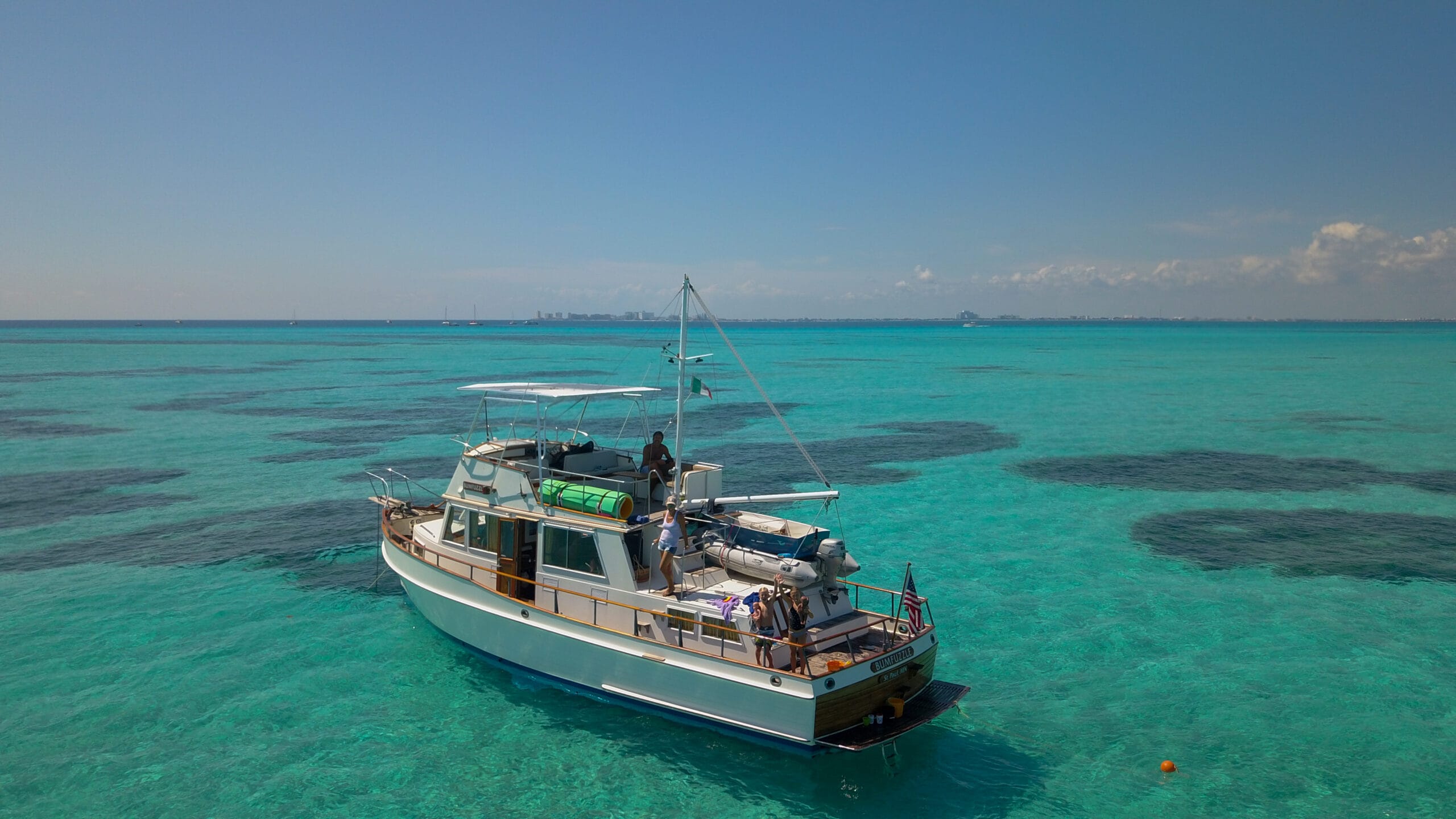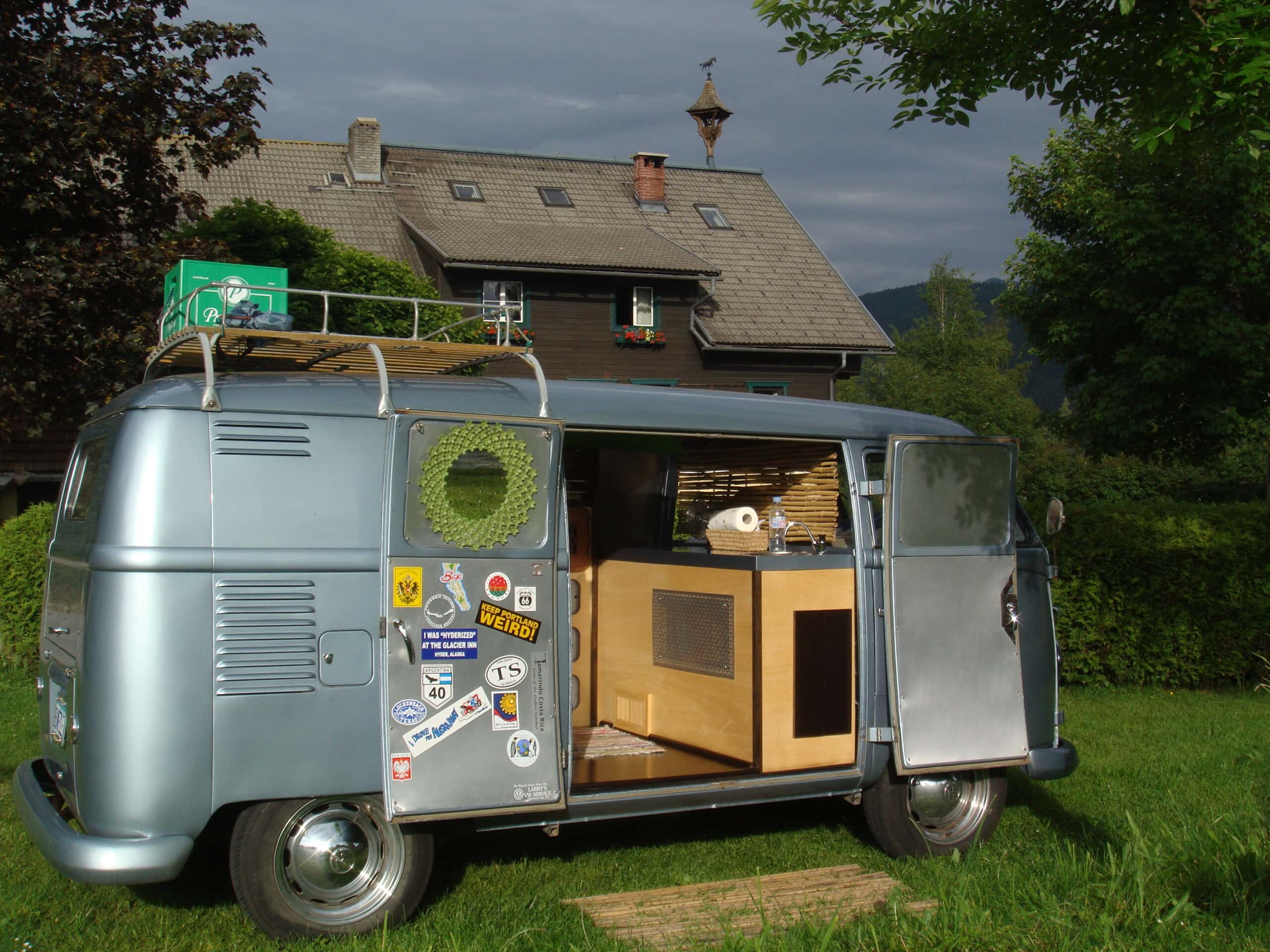Today, I have a great guest post to share from Patrick Schulte from Bumfuzzle. Patrick quit his job around 20 years ago and has been traveling full-time ever since. He and his wife have circumnavigated the world by boat, and have also driven from Alaska to Argentina as well as Europe in a 1958 VW…
Today, I have a great guest post to share from Patrick Schulte from Bumfuzzle. Patrick quit his job around 20 years ago and has been traveling full-time ever since. He and his wife have circumnavigated the world by boat, and have also driven from Alaska to Argentina as well as Europe in a 1958 VW van. Here is how they made it happen. Enjoy!
Life was much simpler when I was content with living the American Dream.
I walked to work from my downtown Chicago condo, traded commodities for a few hours, came home, walked up the street to pick my wife up from her job, walked to a restaurant, walked home, watched tv, went to bed. On the weekends we might take in a Blackhawks game.
That was life.
Relaxing, easy, and comfortable.
We had plenty of money, a nice home, a convertible, didn’t want for anything, and we were still in our twenties.
We should have considered ourselves lucky, had a baby, and moved to the suburbs. That would have been the appropriate next step. Throw in a white picket fence and we would have completed the package.
Instead, within just a few months, we were floating at anchor on a 35’ catamaran in the Bahamas.
It was the kind of dramatic left turn that makes the car’s passenger door fly open in the movies.
My wife and I had decided that we needed an adventure in our life. We gathered up our savings, sold all of our belongings, bought a boat, and set off to sail around the world.
Financially this didn’t make a lot of sense, especially twenty years ago when being a digital nomad was nigh impossible.
But we were young, had no debt, and were loaded with confidence. We figured we’d pick up right where we left off, but four years older and with loads of great stories.
We did get older, and we did rack up lots of stories, but we also decided somewhere along the way that we would never go back to the American Dream. We’d been away from that lifestyle for four years, we’d visited 40 countries, met people from every single point on the personal finance spectrum between $1 and $1 Billion, and returning to our old life no longer held any interest.
That, however, left a gaping hole in our original plan of going back to work in Chicago and starting fresh.
Fortunately, I had been a self-employed commodities trader, and in the past few years, while we were off galavanting around the world, everyone else had been working overtime to turn just about everything into an online job, trading included.
Related content:
We’ve now been full-time world travelers for twenty years.
In addition to sailing around the world, we’ve driven around much of it. We’ve lived in a handful of different vintage vehicles, and are currently anchored in Aruba aboard our third boat.
Along the way I’ve earned a living through stock trading, as well as writing two books, and starting an online investing business to teach others who are interested in living a similar lifestyle.
How did we do it?
Track Your Spending
I’m not the first to say this, and I certainly won’t be the last. But it’s so important, and yet so rarely done, that it bears repeating. It is impossible to make positive financial progress without knowing, in detail, what is in the negative column.
For many years my wife carried a small notebook with her everywhere we went. She wrote down everything we spent, and I do mean everything. We could be in a market in Eritrea, buy ten cents worth of fruit, and she’d whip that book out to note it.
I know most people will find that level of tracking to be too much, and maybe it is a bit too extreme, but after doing that for years we never once had to look at our finances and wonder how the balance fell that month. If there was an anomaly, we knew about it, and we could adjust accordingly. Over time we could estimate our monthly expenses for things like food and entertainment almost to the penny before we’d even gone through the book for that month.
By knowing where your money is going, you can make changes that can make a significant difference. Those differences might not be obvious on a daily basis, but when multiplied by a month, or a year, the amounts can be staggering.
In my book, Live on the Margin, I talked about “extending the burn.” Making changes to your spending habits can easily stretch the finances for a one-year trip into an eighteen-month trip, without any discernible hit to your level of enjoyment.

Start Investing…Yesterday
The stock market can be a scary place for a lot of people, and that keeps them from reaping its benefits.
According to a Gallup poll, in 2021 just 56% of Americans owned stock of some kind, whether through individual investments, or retirement accounts like a 401k or an IRA. That number is down from nearly 67% in 2002.
Many people left the stock market during the Great Recession, and haven’t returned, to their detriment.
Meanwhile, the wealthiest 10% of Americans own 89% of the stock.
Wealth, like it or not, is directly tied to participation in the stock market. It’s imperative to your financial well-being that you are investing.
The earlier you start investing, the better. The stock market always has, and always will, go through periods of boom and bust, but on the whole it has always ended higher. Putting time on your side will make creating and holding onto your wealth that much easier.
To that end, I opened accounts in my kids’ names at a young age. I make regular contributions to it, and sit down with them regularly to pick new stocks, discuss their holdings, explain different investing concepts, economics, and myriad other financial topics that will help them in their adult life.
While sailing around the world it was my passive investments that supported our travels. During that time the stock market increased roughly 50%. My savings grew just about every day.
Even if the principal declined—due to the spending being done to finance our travel—at least the remaining principal wasn’t stagnant.
A checking or savings account simply isn’t going to keep up.
Build First, Before Getting Aggressive
After sailing around the world we returned eager for more adventure. We restored a 1958 VW bus and set off to travel around the world, again.
We lived in that bus for the next two years as we drove from Alaska in the north, to Argentina in the south, and then all over Europe.
Our passive investments had done well for us while we were out sailing, but now on land, with more ready access to the internet, it was beneficial to be a bit more aggressive. Being a lifelong professional trader allowed me to do that, but it’s not the right choice for everyone.
Recently, coinciding closely with the popularity of cryptocurrency, online trading forums, and no-fee stock trading apps, there has been an explosion in small trading account holders. The most widely known is probably Robinhood.
Generally speaking, the increase in new brokerage accounts is a good thing. However, a closer look shows the median account size of a Robinhood user is just $240. If this number begins to grow significantly in the years to come, that will be great, because it will indicate that these new users are focused on their future wealth.
However, numbers suggest otherwise so far.
According to the Federal Reserve, Americans in the top 10% saw their stock market investments grow 43% between January 2020 and June 2021, while the bottom 90% saw their wealth grow at a much lower 33%. Not surprisingly, Robinhood users are some of the most active in the market. Their lower returns then reflect that.
33% is still good growth, but the wealth disparity continues to grow.
I suggest that those new to stock market investing work on buy-and-hold growth strategies early on. A reasonable target is a $20,000 portfolio before deciding whether or not they want to become more aggressive with their investing.
In addition to building up some wealth, investors need to really be sure they are comfortable, or even good at, trading more aggressively with a portion of their money. If you are new to trading, I highly suggest you search out a sort of mentorship from a professional.

Share Your Knowledge
During the VW bus adventure my wife became pregnant with our first child. We confirmed this with a pregnancy test purchased in Rio de Janeiro, and taken on a cargo ship in the Atlantic Ocean while en route to Europe, with our VW bus in the cargo hold.
After a few months of driving around Europe we decided to sell our bus in England and head back to the States. There, we picked up our ‘65 Porsche (long story, family heirloom) from storage, threw a couple of bags in the back, and drove to Mexico to find a nice beach spot to have a baby.
We meandered south along the Pacific Coast, now eight months pregnant, and stopped in Puerto Vallarta. There we found a nice doctor, a sparkly new hospital, and a spot on the beach to relax and settle into life as a family of three.
It was during our early years in Mexico that I began exploring alternative income streams.
I found that the easiest way to do that is to take what you are already an expert at, and use that to teach others how to also become an expert.
We’re all good at something.
You have something in your life that you consider yourself an expert at. It may be something very broad, or something very niche, but whatever it is you have spent a lot of time becoming good at it. Share that knowledge.
For me, that knowledge is trading stocks. It’s what I studied in college, and the one thing I’ve ever really done to earn money as an adult. I’ve spent tens of thousands of hours working on it.
Others might be experts in speaking a second language, welding, computer programming, or a million other things.
Instead of trying to reinvent the wheel, take what you’ve spent years developing as a skill and convert that into an online business.
Second language? Online tutoring. Welding? Online video courses. Computer programming? Freelancing.
The list goes on.
It might take some imagination, and some skills will be more profitable than others, but there is likely a way to take your knowledge on the road with you, share it with others, and get paid for it.
I self-published a couple of books. I’d already gathered a pretty good online following through my travel blog, bumfuzzle.com, and it wasn’t a stretch to write a book about sailing around the world.
After that book I focused on teaching more about trading stocks, and working that into a life of travel and adventure. Live on the Margin specifically targeted an audience that wanted to live the lifestyle I was already living. Again, sell your knowledge.
That book sparked even more questions to my inbox. My goal the past few years had been not to work (in any sort of traditional sense) until my children were five. Now that we’d reached that and I had a little more time available, I decided to branch out a bit and offer to teach individuals how to trade, from start to finish.
Over the next couple of years that business grew into what it is today. At Wanderer Financial I teach people how to invest so they can become financially independent and live freely. My subscribers get a daily live chat full of others who are either out living their wandering life already, or are striving to get there. We discuss stocks, travel, and financial independence. I send out trade alerts whenever I make a trade personally, I teach how to trade stocks and options, send out a weekly market recap newsletter, and much more.
I wake in the mornings, spend an hour looking over the news and going through charts, then open up my Basecamp daily chat where we spend some time throughout the morning discussing the markets and looking for trading opportunities.
After just a few hours I’m done for the day and off to jump in the water with my kids, or go explore whatever island I’m anchored off of. My business is a perfect addition to the work I would already be doing for myself. Now, instead of trading alone, I trade with a group of others who are paying me to share my knowledge.
In addition, I do all of this from a boat in some of the most beautiful places in the world.
Wants vs. Needs
Before having kids people would constantly say to us, “Have fun now, because it’s all over once you have kids.” They’d follow that up with a chuckle and sad vacant eyes.
I understand they were well meaning, and based on their own experiences that had been the case, but we were determined to have a different experience raising kids.
According to a 2015 USDA study, adjusting for inflation, new parents in 2022 can expect a child to cost roughly $300,000 by the time they reach eighteen.
This number is wildly inflated by lifestyle choices. For example, housing a child accounts for roughly one-third of that number.
We chose to raise our children on boats and motorhomes, traveling and experiencing the world around us, with the focus on the outdoor lifestyle that those “housing” choices present.
Our kids have always shared a room. Something which was perfectly normal up until just a generation ago. Hardly a Baby Boomer in America didn’t share a bedroom in their childhood. Suddenly, despite shrinking family size, home square footage has exploded and individual bedrooms are considered an absolute must.
Strike housing cost off of the list for our family.
For us it comes down to recognizing, and acknowledging, the difference between a want and a need. That difference is significant.
For example, individual bedrooms is a want, not a need. It’s a lifestyle choice. So are most things in life. Eating is a need, eating out is a want. A new car is usually a want, not a need. A new toy is a want, not a need. The list is endless.
One thing I have done for years, and continue to do today, is to not buy anything without wanting it at least three times.
This is a great way to eliminate the spontaneous spending in your life. It doesn’t make that want suddenly turn into a need, but it at least forces you through a process of thinking through the purchase.
My children are twelve and ten years old.
They are world travelers who have never lived in a traditional home on land.
They call a boat their home. They speak two languages. They’ve never been to formal school. They were swimming by two and scuba diving by nine. They could pack all their belongings in a suitcase. They are kind, and they are best friends.
Again, everyone is different, and the choices I’ve made won’t fit everyone, but the point is to recognize that there are alternatives. The digital nomad lifestyle affords many opportunities that might not be obvious when plugging away at the formally recognized American Dream.
Recognize the difference between wants and needs, and then adjust your life accordingly in order to achieve your own dream.
Living the Life That You Truly Want
For the last twenty years I feel like I’ve done that.
I’ve traveled to 70 countries while bringing my home with me (boat, VW bus, motorhome). I’ve answered to nobody during that time.
I feel like I’ve raised two good young people, I have a great marriage, success in business, and have truly lived my dreams.
Much of this is due to the lifestyle choices I’ve made, and much of it is due to the opportunities we all have these days thanks to the internet, and the ability to work from anywhere.
The things I’ve listed above are what I consider to be the building blocks that have given me this lifestyle, and I hope that others will find value in them and find them useful in forming their own choices in order to build the life they want.
Author bio: Patrick Schulte is a full-time world traveler and a lifelong trader. He runs Wanderer Financial where he aims to help others invest successfully so that they too can live a financially independent life. He is currently in Aruba aboard his boat Bumfuzzle where he continues to watch the weather and sail off to new destinations. For more information about Wanderer Financial, visit www.wandererfinancial.com, or to follow his travels visit www.bumfuzzle.com where he has been blogging for the past twenty years.
Are you interested in traveling full-time? Why or why not?

